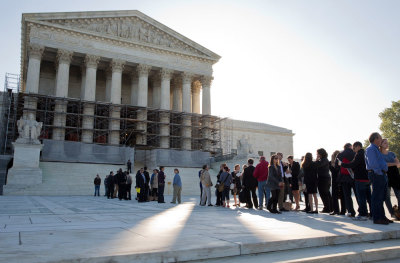Racial admissions preferences: Constitutional or not?

Should the race of a minority student who is applying to a college or university give him or her a decided preference over other applicants? This is the question that a group of college-bound students and their parents are asking the U.S. Supreme Court to address. They want the answer that the court gives to be an unambiguous, no.
The two cases are Students for Fair Admissions v. Harvard College and Students for Fair Admissions v. University of North Carolina. Who are these litigants?
The plaintiffs are members of a non-profit organization, Students for Fair Admissions (SFFA). They are applicants that have been either denied admission or are likely to be denied admission to the two schools which are the defendants — Harvard and the University of North Carolina. The students argue that the reason they were turned down is that those schools favor members of minority racial groups for admission. These students are not members of those groups and maintain that their academic credentials are clearly superior to those admitted from the favored groups. They argue that such an approach to admissions violates either the Equal Protection Clause of the Constitution or Title VI of the Civil Rights Act. The students and their legal counsel are asking the court to reject the holding and reasoning of the most recent case in which the court allowed race to play a part in admissions — Grutter v. Bolinger (2003).
How did we get to this point?
In the early 1970s, Allan Bakke, a would-be medical student seeking admission to UC Davis Medical School, sued the school after being twice rejected. Bakke was challenging the practice of the reservation of a certain number of seats in the entering class for minority applicants, even though their scores and academic records were inferior to his. Though Bakke won his case, the Supreme Court opinion that resulted, Regents of University of California v. Bakke, introduced confusion into college and university admissions nationwide for decades.
The decision was a rarity, described as “4-1-4.” Two groups of justices, four conservatives and four liberals, disagreed on the result. The opinion of the ninth justice, Lewis Powell, was an attempt to join portions of both groups’ opinions in order to allow an overall decision.
Consequently, part of Powell’s opinion agreed with the conservative justices who said that race could not be the sole or isolated factor upon which to base a positive admissions decision. Numerical quotas were unconstitutional, and special set-asides that UC Davis was using were out.
At the same time, Powell joined the liberal wing by saying that race could be “a factor” along with many others in the admissions decision. He also rejected the liberal justices’ claim that racial preferences were necessary to overcome past racial discrimination. However, he allowed that a diverse student body would produce a “robust exchange of ideas,” in other words a sort of intellectual diversity that was desirable for an educational institution. The result was that “both sides claimed at least a partial victory.”
The ambiguity of Bakke continued until 1998 when two young women, Barbara Grutter and Jennifer Gratz, represented by the Center for Individual Rights, challenged the racially preferential admissions practices of the University of Michigan. Neither were members of minority groups. Both had applied to Michigan, but unsuccessfully. Gratz was rejected by the undergraduate college at Michigan and Grutter was denied admission to the University of Michigan Law School. The cases made their way to the Supreme Court for the 2002-2003 term. Unfortunately, the court perpetuated the confused holdings of Bakke. In both cases, the race of an applicant was allowed to be retained as a plus for admissions. However, in Gratz the court found in Jennifer Gratz’s favor because the undergraduate college at U of M had made race “decisive” in the admission decision with a point system that the opinion called “mechanical.”
However, the court upheld the Law School’s admissions practices even though it used racial classifications that clearly skewed admissions decisions. Justice Sandra Day O’Connor’s opinion recognized that although racial classifications used by public universities should be strictly scrutinized by the court because their use was suspect, the law school’s classifications were, nevertheless, justified. Why? Because they were furthering certain “compelling state interests.” Those compelling interests were produced by its admissions policies which guaranteed a “racially diverse student body.” That diverse student body in turn yielded laudable educational benefits such as increasing “cross-cultural understanding,” the “breaking down of racial stereotypes,” and the better preparing of law students “to participate in a diverse workforce.”
But did these benefits reach the level of being “compelling?” O’Connor’s opinion left that assessment entirely to the university’s educational expertise. O’Connor wrote: “The Law School’s educational judgment that such diversity is essential to its educational mission is one to which we defer” (emphasis mine).
Commentators Richard Sander and Stuart Taylor, Jr. sum up the harmful effects of Bakke and Grutter: “[T]he Court’s holdings were half-measures that effectively encouraged schools to obscure the workings of their preference policies. Both opinions emboldened many schools to perpetuate and even enlarge their racial preferences.” That result became so pronounced and obvious that it led to the two cases involving Students for Fair Admissions which are before the court this term.
In both the cases — the Harvard case and the UNC case — lengthy trials unearthed considerable factual evidence which showed that race played an important and repeated part during the admission process. That is precisely what the plaintiff students find unfair and unconstitutional. Here are some examples from the Harvard case:
Preferential treatment began with early recruiting. Harvard recruited high school African American and Hispanic students with PSAT (Preliminary SAT) of scores of 1100 or above. However, it did not recruit white or Asian American students unless they had scored at least 1350 on the same test.
Preferential treatment continued as the new entering class was constructed. As the freshman class was forming each year, Harvard closely and regularly monitored the projected racial make-up of the class by using “one-pagers.” These documents kept track of the new class’s racial composition on a daily basis comparing last year’s class, in terms of race, with the new class being formed.
The Dean of Admissions also periodically informed admissions officers about the racial contours the new class was taking. It was clear that this “information” was aimed at keeping the racial composition of the class, similar by race, to the previous year’s class.
As the new class took more and more shape, Harvard engaged in “loping” off certain tentatively accepted applicants in order to bring its class into racial balance.
Testimony by plaintiff’s experts reviewed the test scores and GPAs of similarly qualified Harvard applicants organized by race. An Asian American in the 4th lowest decile (bottom 40%) in terms of his academic credentials had virtually no chance of admission (0.9%). However, an African American whose scores put him in the same academic decile had a substantially higher chance of admission (12.8%) and, remarkably, that African American student had a slightly higher chance of admission than an Asian America applicant whose academic credentials put him in the top decile, that is the top 10% of those applying.
Harvard’s own Office of Institutional Research agreed that the admission process put Asian American applicants at a disadvantage and that “being Asian” was a negative for getting into Harvard. Note: Although Asian Americans were a minority group, they were not a favored minority group.
Grutter also required colleges and universities which were using race to determine if there were alternative admission practices that would be race-neutral and yet provide a diverse student body. Both UNC and Harvard were presented during the legal proceedings with proposals for race-neutral restructuring of their admissions practices. Those proposals called for eliminating racial preferences, as well as preferences for children of donors, alumni, and faculty/staff. In addition, by reducing preferences for recruited athletes and increasing scholarships for applicants in lower socio-economic groups (defined in a race-neutral way), the likelihood of true student diversity was maintained. In other words, an entering class under race-neutral alternative plans displayed a variety (diversity) of backgrounds, geographic differences, experiences, and viewpoints, and yes, racial differences. All this could be accomplished without using race in the way it was being used. Harvard and UNC both rejected these alternatives as unworkable.
The plaintiffs also argued in their briefs that in California, where race-based admissions had been banned by law, universities there were nevertheless able to restructure their admissions in a race-neutral way and still achieve the diversity of the student entrants that those universities desired. Other states had also abided by similar bans while retaining true diversity.
The late Justice Scalia was prescient in his dissent in Grutter. He complained that instead of “a clear constitutional holding that racial preferences in state educational institutions are impermissible,” the court rendered the “Grutter-Gratz split double header” that was “perversely designed to prolong the controversy and litigation.” That is exactly what has happened.
And now, the court has an opportunity to repudiate Grutter and eliminate race from admissions decisions by state institutions or private ones which receive federal monies. Justice Thomas forcefully explains why racial preferences in admissions should not continue: “Every time the government places citizens on racial registers and makes race relevant to the provision of burdens or benefits, it demeans us all.”
John A. Sparks is the retired dean of the Alva J. Calderwood School of Arts & Letters at Grove City College, where he teaches U.S. Constitutional history and business law, and was the former chairman of the business department. A fellow for educational policy with The Center for Vision & Values, he has been named an H.B. Earhart Fo undation Fellow, an R.C. Hoiles Fellow, a Chavanne Fellow (Baylor University Hankamer School of Business), and has received the prestigious George Washington Honor Medal from the Freedoms Foundation, Valley Forge, PA.




























